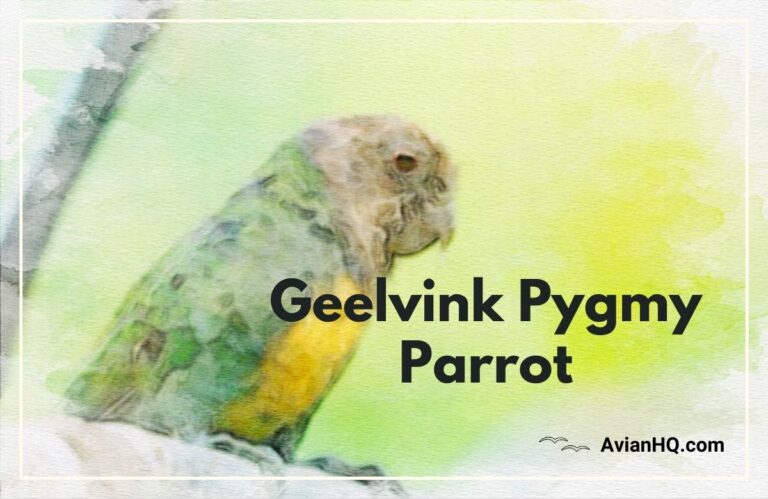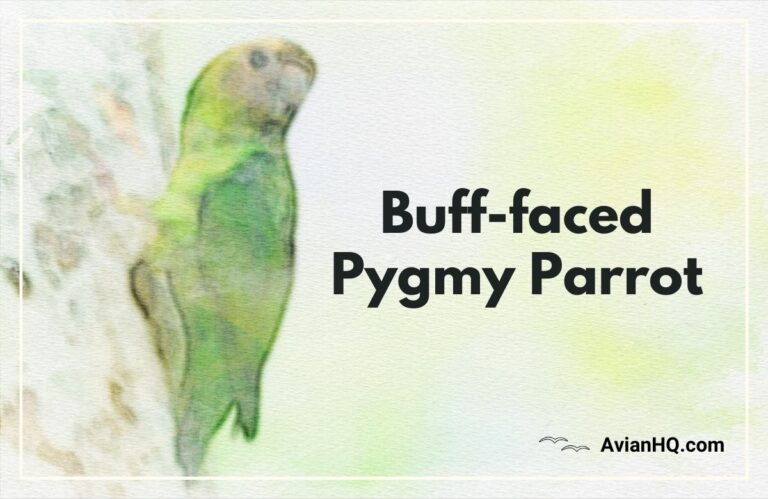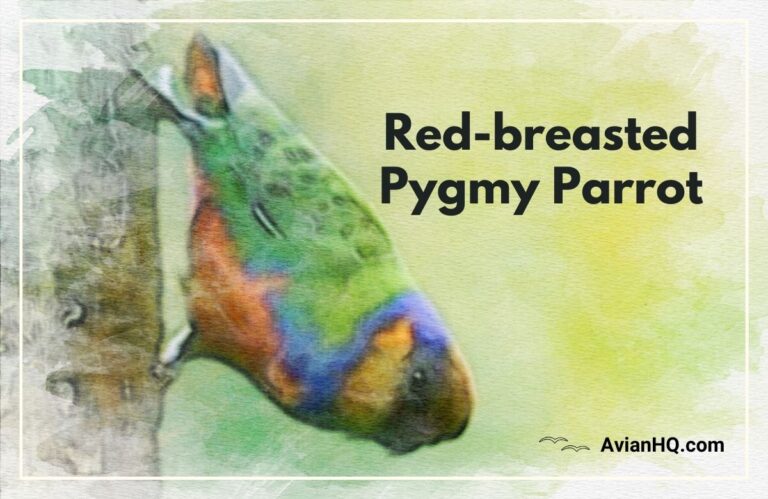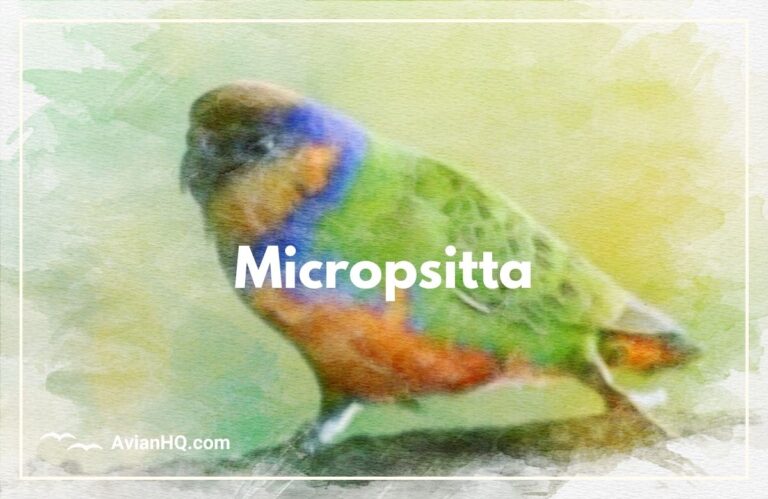Finsch’s Pygmy Parrot (Micropsitta finschii)
Dotting the dense rainforest canopies of New Guinea and the Solomon Islands is one of the most colorful and charismatic miniature parrots in the world – the Finsch’s Pygmy Parrot. Though small in stature, this vibrant species packs huge personality into it’s bright plumage in shades of green, blue, yellow, and orange.
The Finsch’s Pygmy Parrot (Micropsitta finschii), also known by the common name Emerald Pygmy Parrot, is the tiniest representative of the parrot family Psittacidae across it’s Australasian range. Adults reach only 9-10 cm (3.5-4 in) in length and weigh approximately 12 g (0.4 oz) on average. Their diminutive size allows them to dexterously hop between branches and hang upside down while foraging.
Weighing about the same as a tablespoon of water, these tiny parrots earned the name “pygmy parrot.” But their small stature does not prevent them from leading vigorous, active lifestyles in the forest canopy. They energetically survey their territory, communicate loudly with other birds, and acrobatically scour branches and trunks for their next meal.
As their common name suggests, vibrant emerald greens cover much of the body plumage. This provides excellent camouflage among the rainforest foliage. Brilliant highlights in captivating shades of sapphire, azure, saffron, and crimson add striking contrast to their overall jewel-toned appearance.
Keep reading to learn all about the taxonomy, natural history, and conservation status of this eye-catching little parrot. Discover where to spot them in their island forest habitats and how to identify their melodious vocalizations.
taxonomy and naming:
A Miniature Member of the Parrot Family
The Finsch’s Pygmy Parrot is classified in the genus Micropsitta, which contains all six species of pygmy parrots native to New Guinea and nearby islands. Genus Micropsitta belongs to the subfamily Micropsittinae within the broad parrot family Psittacidae.
Taxonomy and Naming
The species is further divided into 5 distinct subspecies based on geographic isolation and subtle variations in appearance:
- M. f. finschii – native to the southern Solomon Islands
- M. f. aolae – inhabits the central Solomon Islands
- M. f. tristami – restricted to the western Solomon Islands
- M. f. nanina – found in the northern Solomon Islands and on Bougainville Island
- M. f. viridifrons – located in the Bismarck Archipelago and islands off northeastern New Guinea
The Finsch’s Pygmy Parrot was named in honor of the prolific German ethnographer, naturalist and colonial explorer Friedrich Finsch. The species name finschii pays tribute to his contributions to ornithology in the Pacific.
The original scientific description was published in 1881 by the Australian ornithologist Edward Pierson Ramsay.
Physical Appearance
The brilliant plumage of the Finsch’s Pygmy Parrot provides excellent camouflage among rainforest leaves while also adding mesmerizing pops of color.
As their alternate common name “Emerald Pygmy Parrot” suggests, vibrant emerald green hues cover the body from the forehead to the belly. The verdant green plumage is richer and more yellow-tinged on the upper body and wings.
Splashes of captivating cyan, azure, saffron, and crimson create striking contrast against the prevailing green. The specific colors and patterns vary somewhat between the subspecies and between genders.
Some defining features of their plumage include:
- Blue patch on the crown of the head
- Blue or pink feathers around the base of the beak
- Yellow undertail coverts
- Orange-red spot on the center of the abdomen and belly of males
- Dark slate-grey bill and orange or pink irises
- Females lack some of the bright belly and beak markings seen in males
Juveniles have more muted green plumage overall, with paler beak colors that darken as they mature. Their eyes may appear reddish-brown before transitioning to the bright orange or pink of adults.
The Pygmy Parrot’s compact body is perfectly suited for clambering through branches. And their short but wide tails help prop them up as they acrobatically forage for food. Their vibrant plumage patterns provide the finishing touches on their charming miniature frames.
Habitat and Distribution
The Finsch’s Pygmy Parrot is endemic to the tropical rainforests of New Guinea, the Bismarck Archipelago, and the Solomon Islands.
Each subspecies has it’s own distinct range:
- M. f. finschii – southern Solomon Islands
- M. f. aolae – central Solomon Islands
- M. f. tristami – western Solomon Islands
- M. f. nanina – northern Solomon Islands and Bougainville Island
- M. f. viridifrons – New Ireland and Bismarck Archipelago
They thrive in lowland and mid-elevation primary rainforests up to approximately 900 m (2,950 ft) above sea level. At higher elevations, they are replaced by species like the Red-breasted Pygmy Parrot.
Though most abundant in intact primary forest, Finsch’s Pygmy Parrots readily inhabit secondary growth and gardens adjacent to forest edges. They prefer areas of dense, mature vegetation.
These active little parrots spend most of their time foraging high in the rainforest canopy, using their curved beaks and strong feet to climb, hop, and hang upside down. The green hues of their plumage provide excellent camouflage among the leaves.
But their bright blue, yellow, and red markings sometimes give away their location when viewed up close. Keep an eye out for these pops of color high in the treetops!
Diet and Feeding
The diet of wild Finsch’s Pygmy Parrots consists primarily of plant-based foods foraged from the rainforest trees:
- Lichens
- Fungi
- Seeds
- Some insects and insect larvae
Lichens and fungi make up the bulk of their diet. Using their curved upper beak like a hook, they are able to pick and pry small food items off bark, leaves, vines, and epiphytes.
You may see them plucking and consuming seeds from the cones of Casuarina trees. Their specialized toe arrangement – two forward, two backward – allows them to dexterously cling and climb along branches.
While feeding, Finsch’s Pygmy Parrots use their short but wide tails as a prop against tree trunks and branches. This allows them to maintain balance while acrobatically hanging upside down as they forage.
Insects and larvae provide essential proteins, fats, and vitamins to supplement their primary plant-based diet. This includes consuming some tree sap, which has insecticidal properties that help rid the birds’ feathers of parasites.
Though tiny, Finsch’s Pygmy Parrots are voracious and ambitious eaters. Their high-energy lifestyles demand a frequent intake of calories. You may even see the parrots ingesting grit or small pebbles to aid their digestion, since they lack crop functionality.
Breeding and Nesting
The breeding season for Finsch’s Pygmy Parrots extends from March through May annually. During this period, mated pairs excavate nesting cavities inside the arboreal nests of termites.
Both males and females partake in hollowing out the entrance tunnel that leads to the nesting chamber within the termite mound. The birds continue to use this roosting cavity even outside of the breeding season.
Females typically lay clutches of 1-2 small white eggs within the protected chamber of the termite nest. The average dimensions of the eggs measure approximately 0.65 x 0.6 in (16.5 x 14.5 mm).
Both parents participate in incubating the eggs and feeding the chicks once they hatch. The altricial hatchlings are blind and helpless at birth. But they grow quickly under the diligent care of their parents before fledging at maturity.
Nesting within active termite mounds likely helps conceal the birds from predators. The constant temperature and humidity inside the mounds may also facilitate egg incubation.
Little is known about precise incubation times, chick development, and length of parental care since wild pairs have low breeding success in captivity. But in the undisturbed tropical rainforest, nesting in hidden tree hollows provides safety for raising the next generation of vibrant little parrots.
Behavior and Ecology
The Finsch’s Pygmy Parrot is a highly energetic and social species. Their activity patterns and behaviors reflect their active lifestyles.
Though most often seen alone, in pairs, or in family units, small flocks of 3-6 individuals may forage and travel together as well. Flocks likely consist of mated pairs along with recent fledglings still dependent on their parents.
You can often hear Finsch’s Pygmy Parrots before catching a glimpse of them, thanks to their wide repertoire of loud and frequent vocalizations. They use calls and contact calls to communicate with flock members and defend territories.
Distinctive vocalizations include:
- Whistles
- Squawks
- Chattering
- Alarm calls
- Contact calls
Their whistled song consists of repeated single note pairs, with the second note at a higher pitch. The series is repeated 2-3 times in succession.
Roosting and nesting in the protected cavities of arboreal termite mounds provide respite from their highly active routines. But soon enough, their high energy has them on the move again, clambering through branches in search of food.
You may even observe the sociable birds foraging in mixed flocks along with other small bird species. But their bright green plumage makes them stand out from the crowd.
Conservation Status
The global population size and density of Finsch’s Pygmy Parrots has not been precisely quantified. But based on field observations, experts estimate their numbers to be in the tens of thousands at minimum, likely much greater.
Their population appears to be remaining stable without significant declines. As such, the Finsch’s Pygmy Parrot is categorized as Least Concern on the IUCN Red List of Threatened Species.
However, habitat loss poses localized threats in some parts of their island distribution:
- Logging and deforestation in lowland rainforests
- Forest degradation from human settlement and agriculture
- Predation by invasive species in fragmented forests
Their small island populations and restricted ranges make them more vulnerable to extinction if threats are not effectively managed.
Conservation efforts necessary to protect the species include:
- Preserving intact primary rainforest across their geographic ranges
- Monitoring populations and habitat trends
- Controlling logging and agricultural expansion near protected areas
- Removing invasive predators from island habitats
- Educating local communities on sustainable use of forest resources
With proper habitat conservation, the outlook remains positive for this charming and colorful pygmy parrot to continue brightening it’s tropical island homes.
Cultural Significance
The vibrant colors and energetic nature of the Finsch’s Pygmy Parrot have made them endearing to local indigenous communities across New Guinea and the Solomon Islands.
Seeing a flash of green and blue darting through the forest canopy is considered a sign of life and vitality. The birds’ loud vocalizations are said to energize the forest.
In some traditional stories and myths, the Pygmy Parrot is a messenger that carries news between villages. Their green plumage represented new growth and rebirth.
And their acrobatic climbing skills have inspired young hunters and warriors. Catching a glimpse of a Pygmy Parrot climbing effortlessly inspired training to improve agility and stamina.
Indigenous groups also widely considered the Pygmy Parrot to be a symbol of love and partnership, since mated pairs remain monogamous and work cooperatively to raise their young together.
Unfortunately, some trapping of the birds for the pet trade has occurred in localized areas. But further research is needed to determine the full scope of this threat to wild populations.
Overall, the species maintains cultural significance across it’s home islands. And it’s bright colors and behaviors continue inspiring indigenous art and storytelling today.
Conclusion
The brilliant emerald greens, vivid blues, and warm oranges of the Finsch’s Pygmy Parrot make it one of the most strikingly colored of all the pygmy parrots.
Though tiny, usually reaching only 9-10 cm (3.5-4 in) in length, they lead remarkably energetic lifestyles. Their days are spent actively climbing, hopping, hanging upside down and vocalizing loudly as they forage in rainforest canopies.
Endemic to tropical islands in New Guinea, the Bismarck Archipelago, and the Solomon Islands, they play important ecological roles in their island forest ecosystems.
While population trends remain stable, habitat loss poses real threats. And their limited island distributions make them more vulnerable to extinction if threats are not controlled.
But with proper habitat conservation, we can ensure the Finsch’s Pygmy Parrot continues to brighten it’s island homes for centuries to come. The vibrant spirit of this tiny parrot reminds us that great things often come in small packages.
Want to catch your own glimpse of the Finsch’s Pygmy Parrot? Plan a birdwatching adventure to the tropical forests of New Guinea or the Solomon Islands. Listen for their whistles and squawks echoing through the canopy. With some patience and luck, you may spot a flash of brilliant color as a pair flits through the leaves.







